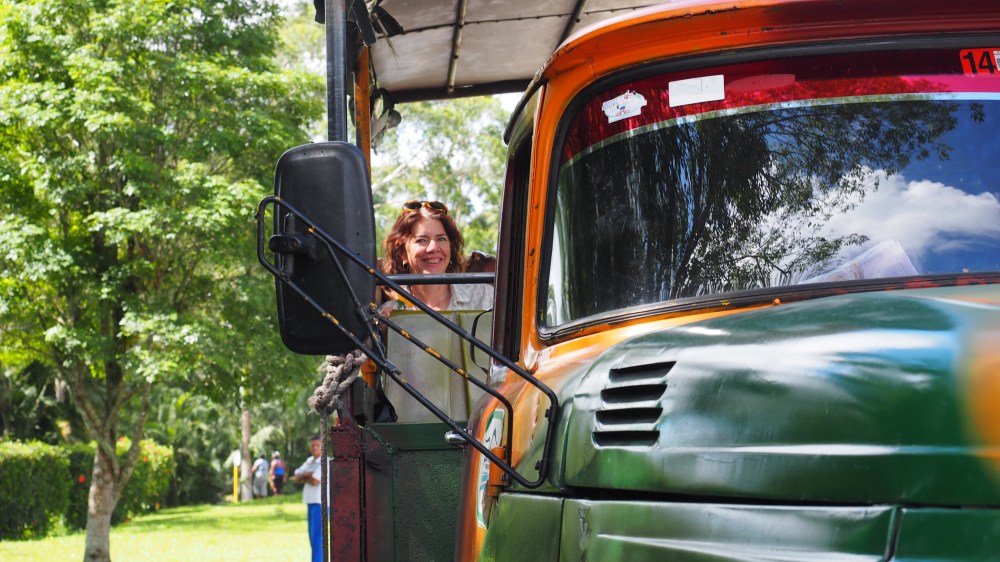Saturday, 23 May 2015
Topes de Collantes is a nature reserve located high in the Escambray Mountains, in the hinterland behind Trinidad. We had booked a tour of the reserve on the day we arrived. After another vast breakfast in the casa we headed to the Cubatur office on a nearby corner to meet the tour guide. Around 9 a.m., the guide led us to Parque Céspedes where we bundled onto a Russian army truck painted in Rastafarian colours. There were about 20 tourists in the group, mostly Europeans.
We left Trinidad via the road to Cienfuegos, but we soon turned off and started winding our way up steep roads into the Escambray Mountains. The truck’s motor roared like a brontosaurus dying of rage, and the diesel fumes provided a suitable olfactory complement.
Although the road signs strictly prohibited any overtaking, the driver of a yellow taxi behind us tried to accelerate past the truck. There was a large noise as it was momentarily caught between the guardrail and the truck’s vast bumper bar. When we caught up with the taxi at the lookout ahead, there was a long groove of naked metal smeared along one of the side panels.
When we disembarked at the lookout, we walked past a man sitting on some stone steps with a cardboard box that contained a huge tarantula. No doubt you could pay to have yourself photographed with it, but most of the tourists (including me) were too horrified even to look at it closely. I heard one woman swear loudly in Dutch as soon as she caught sight of it: Godverdomme!
The mirador (lookout) afforded breathtaking views of Trinidad and the surrounding coastline. Susie took some photographs and we managed to evade the heat in the shade of a tree by the roadside until the bus set off again.
The main building in the town of Topes de Collantes was a vast sanatorium for TB sufferers which had been converted into a health resort for the treatment of a more modern epidemic: stress.
The next stop was a café that served locally-made coffee that is exported to Japan. The coffee was indeed good but perhaps not as good as Maria’s café back in Las Terrazas. There was a display outside with some industrial artefacts associated with coffee production from years gone by.

The main activity of the day was a 7 km hike through the rainforest to Caburní falls in a valley far below the town of Topes de Collantes. The walk was arduous but manageable due to the cover of the forest canopy. The only problem was the unrelenting Dutch chatter that disrupted the natural ambience.
The first waterfall was only a photo opportunity. The second was smaller and still quite impressive to behold, but it had a deep, cool water hole next to it. We stayed there for an hour or so, swimming beneath the falls and sitting around on ledges beneath the water, enjoying the shade and the sights and sounds of the forest. We headed back up the valley ahead of the main group so we could enjoy the quiet of the forest and the ubiquitous birdcalls.
On our way out of the valley we came across a small hut seemingly in the middle of nowhere that served chilled juice. Susie had the best juice ever: sour mandarin and orange. Tamarind and peach juice was also available, but I opted for a cool beer.
After a short ride in the truck we stopped at a restaurant outside Topes de Collantes that served rather ordinary food. Susie had a pleasant conversation with some female Dutch tourists. I struck up a discussion with a Turkish man who lived in Germany. He was well-informed politically, but avoided discussing politics with the other European tourists. “I’m on holiday, I don’t want to talk politics” I heard him complain at one point during the meal. Later, discussion about EU membership again entered dangerous territory. A Dutch tourist observed that EU member states contribute money, “But what do they get in return?” he asked rhetorically. The Turkish guy replied without missing a beat, “It’s about ideals, not money”.
As we finished our meal, dark storm clouds appeared between the surrounding peaks, and on the drive back down to Trinidad, the heavens opened. Those at the front of the truck did their best to hold a tarpaulin down, but cold rain blew in, and the canvas above our seat started leaking. Susie moved back a seat to avoid stream of cold drips, but I just sat it out. It was after all quite a novelty to be cold as well as wet.
As we drove into Trinidad, the streets that ran downhill towards the sea had become rivers of swift moving brown water, in some places several feet deep. Cars and bici-taxis had pulled over and battened down as best they could. The big Russian truck lumbered on, however, and dropped us off in the Parque Céspedes. By this time the rain had abated, and we were able to walk back to the casa in relative comfort.
Back at the casa we changed into some dry clothes and sought out a beer in the ruins of the theatre. While we were there, a couple of campesinos stopped by on their horses and hitched them in a narrow in-set next to the ruins.
We later tried out a restaurant called San José in the street where we were staying. It had been recommended to us by a German tourist. The food and drink was reasonably priced; the servings were vast, and the quality was excellent. We returned there several times before we left Trinidad.
